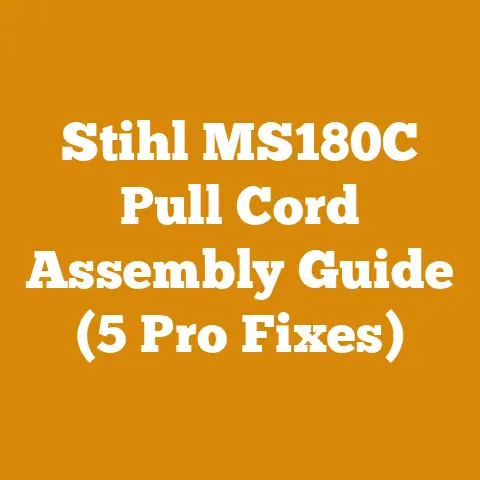Treated Wood Landscape Timbers (5 Safety Tips Every Logger Must Know)
Treated Wood Landscape Timbers: 5 Safety Tips Every Logger Must Know (and a Deep Dive into Costs!)
I remember the first time I saw a stack of perfectly uniform, pressure-treated landscape timbers. The green hue was unmistakable, and the promise of easy landscaping was alluring. But even then, a little voice in the back of my head, honed by years of working with wood in its rawest form, whispered, “There’s more to this than meets the eye.” That “more” is what we’re diving into today: the safety concerns surrounding treated wood, especially landscape timbers, and the often-overlooked costs associated with handling and disposing of them. We’ll also touch on the financial side, because let’s face it, understanding costs is just as crucial as understanding safety when you’re working with wood.
Why This Matters: A Logger’s Perspective
As a logger or anyone involved in wood processing, you’re likely familiar with handling raw timber. But treated wood presents a different beast altogether. These timbers, designed for ground contact and long-term durability, are impregnated with chemicals to resist decay, insects, and fungi. While these treatments extend the lifespan of the wood, they also introduce potential health hazards if not handled correctly. And while you might not be installing landscape timbers, you might be clearing land where they’re present, processing them for disposal, or even repurposing them (which, by the way, comes with its own set of concerns).
The Elephant in the Room: Understanding the Costs
Before we get to the safety tips, let’s address the financial elephant in the room. Treated wood isn’t free, and neither is dealing with it. I’ve seen many small logging operations underestimate the costs involved in handling treated wood, leading to budget overruns and even financial strain.
1. Purchase Price and Alternatives
The initial cost of treated wood landscape timbers varies depending on the size, grade, and treatment type. As of late 2024, you can expect to pay anywhere from $8 to $25 per 8-foot timber at major retailers like Home Depot or Lowe’s. However, regional variations and lumber yard prices can significantly impact this.
- Data Point: A 2023 report by the Forest Products Laboratory (FPL) estimates that the average cost of pressure-treated lumber has increased by 15-20% over the past five years, driven by rising chemical prices and increased demand.
But what about alternatives? If you’re considering using treated wood, it’s crucial to compare the cost with naturally durable wood species like cedar, redwood, or black locust. These species, while potentially more expensive upfront, don’t require chemical treatment and offer a longer lifespan in certain applications.
- Example: Cedar landscape timbers might cost $15-$35 per 8-foot piece, but their natural resistance to decay could save you money in the long run by reducing the need for replacement.
2. Disposal Costs: A Hidden Expense
This is where many people get caught. Treated wood cannot be burned in open fires or fireplaces. The chemicals released during combustion are highly toxic and pose a serious health risk. Furthermore, treated wood should never be used as mulch or compost.
Disposing of treated wood requires specialized handling and landfill disposal. Many landfills charge a higher fee for treated wood due to its potential environmental impact.
- Data Point: The average cost of disposing of treated wood in a landfill ranges from $50 to $150 per ton, depending on your location and the landfill’s policies. Some landfills may even refuse to accept treated wood altogether.
I’ve personally seen logging crews leave treated timbers on site to avoid the disposal fees, which is a terrible practice. It’s crucial to factor in these disposal costs when budgeting for any project involving treated wood.
- Personal Story: I once worked on a land clearing project where the client hadn’t disclosed the presence of several old treated wood retaining walls. The unexpected disposal costs added thousands of dollars to the project budget, causing significant friction. We had to renegotiate the contract to cover the additional expenses.
3. Tool Maintenance and Replacement
Cutting treated wood dulls saw blades faster than untreated wood. The chemicals in the wood act as an abrasive, wearing down the cutting edges. This means you’ll need to sharpen or replace your chainsaw blades more frequently, adding to your overall costs.
- Calculation: A chainsaw blade typically costs $20-$50 to replace. If you’re cutting a significant amount of treated wood, you might need to replace your blade twice as often, effectively doubling your blade costs.
I recommend using carbide-tipped saw blades when cutting treated wood. These blades are more resistant to wear and tear and will last longer, saving you money in the long run.
- Pro Tip: Invest in a good quality chainsaw sharpener. Maintaining a sharp blade will not only improve your cutting efficiency but also reduce the strain on your chainsaw engine, extending its lifespan.
4. Labor Costs: Handling with Care
Handling treated wood requires extra precautions, including wearing protective gear like gloves, eye protection, and a dust mask. This adds time to the project, which translates to increased labor costs.
- Data Point: A 2022 study by the National Institute for Occupational Safety and Health (NIOSH) found that workers who regularly handle treated wood are at a higher risk of developing skin irritations and respiratory problems.
It’s crucial to train your crew on the proper handling procedures for treated wood and to provide them with the necessary protective equipment. This will not only protect their health but also reduce the risk of workplace injuries, which can lead to costly workers’ compensation claims.
5. Permitting and Regulations
Depending on your location, you may need permits to handle or dispose of treated wood. Some municipalities have specific regulations regarding the storage and transportation of treated wood.
- Example: In some states, you may need to obtain a special permit to transport treated wood across state lines. Failure to comply with these regulations can result in hefty fines.
Always check with your local authorities to ensure you’re complying with all applicable regulations. Ignorance of the law is no excuse, and the cost of non-compliance can be significant.
5 Safety Tips Every Logger Must Know
Now that we’ve covered the cost considerations, let’s get to the heart of the matter: safety. Here are five crucial safety tips every logger or wood processor should follow when handling treated wood landscape timbers:
1. Know Your Treatment: Understanding the Chemicals
The first step in protecting yourself is understanding what chemicals are used to treat the wood. While Chromated Copper Arsenate (CCA) was phased out for residential use in 2003, older landscape timbers might still contain it. Newer treatments commonly use Alkaline Copper Quaternary (ACQ), Copper Azole (CA), or micronized copper formulations.
- Why it matters: CCA contains arsenic, a known carcinogen. ACQ and CA are generally considered less toxic, but they can still cause skin and eye irritation. Micronized copper treatments are considered even safer, but precautions are still necessary.
- Actionable Tip: If you’re unsure of the treatment type, treat all treated wood as potentially hazardous. Always err on the side of caution.
2. Gear Up: Personal Protective Equipment (PPE) is Non-Negotiable
This is where I see a lot of corner-cutting, and it’s simply not worth it. The right PPE is your first line of defense against harmful chemicals.
- What you need:
- Gloves: Wear waterproof, chemical-resistant gloves (nitrile or neoprene are good choices) to prevent skin contact. Cloth gloves are useless.
- Eye Protection: Safety glasses or a face shield are essential to protect your eyes from dust and splinters.
- Dust Mask/Respirator: A properly fitted N95 dust mask is a minimum requirement when cutting or sanding treated wood. For heavier exposure, consider a respirator with a P100 filter.
- Long Sleeves and Pants: Cover your skin to minimize contact with treated wood dust and debris.
- Why it matters: Direct skin contact with treated wood can cause dermatitis (skin irritation). Inhaling treated wood dust can lead to respiratory problems and, in the case of CCA, long-term health risks.
3. Work Smart: Minimizing Dust and Contact
The goal is to reduce your exposure to treated wood chemicals as much as possible. Here’s how:
- Wet Sawing: If possible, use a wet saw or spray the wood with water while cutting. This helps to suppress dust.
- Work Outdoors or in a Well-Ventilated Area: Avoid cutting or sanding treated wood indoors. If you must work indoors, ensure adequate ventilation.
- Avoid Burning: As mentioned earlier, never burn treated wood. The smoke and ash contain toxic chemicals.
- Don’t Eat, Drink, or Smoke: Wash your hands thoroughly with soap and water before eating, drinking, or smoking. This prevents accidental ingestion of treated wood chemicals.
- Clean Up: Vacuum up treated wood dust and debris with a HEPA filter vacuum. Sweep up larger pieces and dispose of them properly.
4. Waste Disposal: Doing it Right
Proper disposal of treated wood is crucial for protecting the environment and public health.
- Landfill Disposal: The most common method is landfill disposal. Contact your local landfill to inquire about their policies and fees for accepting treated wood.
- Recycling (Limited): Some facilities may recycle treated wood for specific applications, such as composite decking. Check with your local waste management authorities for options.
- Never Use as Mulch or Compost: Treated wood chemicals can leach into the soil and contaminate plants.
- Proper Storage: Store treated wood scraps in a designated area away from children and pets.
5. Awareness and Training: Knowledge is Power
This is perhaps the most important tip of all. Ensure that you and your crew are fully aware of the risks associated with treated wood and are properly trained in safe handling and disposal procedures.
- Resources: Consult the Environmental Protection Agency (EPA), the Forest Products Laboratory (FPL), and your local health department for information on treated wood safety.
- Training: Conduct regular safety training sessions for your crew, covering topics such as PPE, safe work practices, and proper disposal methods.
- Communication: Encourage open communication about safety concerns. If someone is feeling unwell or has concerns about a specific task, address them immediately.
Case Study: A Real-World Example
I once consulted with a small logging operation that was tasked with clearing a site containing a significant amount of old, treated wood landscape timbers. The crew was initially unaware of the potential hazards and were handling the wood without proper PPE. They were also burning the scraps in an open fire, releasing toxic chemicals into the air.
- Providing the crew with proper PPE (gloves, eye protection, dust masks).
- Training them on safe handling and disposal procedures.
- Arranging for proper landfill disposal of the treated wood.
- Monitoring air quality during the project.
The result was a safer and more environmentally responsible project. The crew’s health was protected, and the surrounding community was spared from exposure to toxic chemicals.
Budgeting for Safety: An Investment, Not an Expense
Many loggers view safety measures as an expense, but I see them as an investment. By investing in proper PPE, training, and disposal methods, you’re protecting your crew’s health, reducing the risk of accidents, and avoiding costly fines.
- Example: A good quality respirator might cost $50-$100, but it’s a small price to pay compared to the cost of treating a respiratory illness or paying a workers’ compensation claim.
When budgeting for a project involving treated wood, be sure to include the following safety-related costs:
- PPE (gloves, eye protection, dust masks, respirators)
- Training materials and time
- Disposal fees
- Permitting fees (if applicable)
- Tool maintenance and replacement (carbide-tipped saw blades)
The Bottom Line: Safety First, Always
Handling treated wood landscape timbers presents both safety challenges and cost considerations. By understanding the risks, following safe work practices, and budgeting appropriately, you can protect your health, your crew’s health, and the environment. Remember, safety is not just a slogan; it’s a way of life. And in the logging and wood processing industry, it’s a way to ensure long-term success and sustainability. Stay safe out there, and happy logging!






